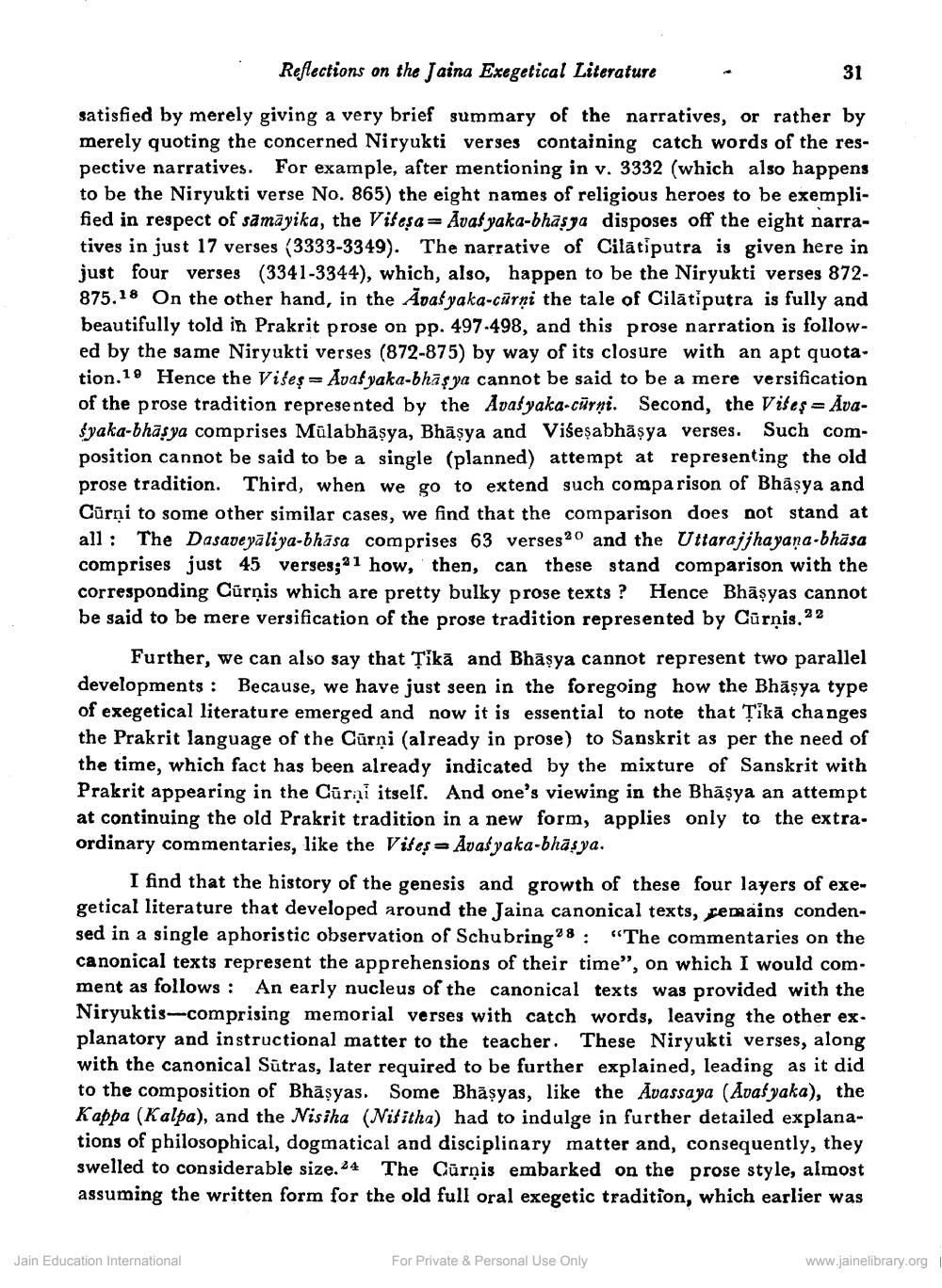Book Title: Reflections on the Jaina Exgetical Literature Author(s): B K Khadabadi Publisher: Z_Aspect_of_Jainology_Part_3_Pundit_Dalsukh_Malvaniya_012017.pdf View full book textPage 5
________________ Reflections on the Jaina Exegetical Literature 31 satisfied by merely giving a very brief summary of the narratives, or rather by merely quoting the concerned Niryukti verses containing catch words of the respective narratives. For example, after mentioning in v. 3332 (which also happens to be the Niryukti verse No. 865) the eight names of religious heroes to be exemplified in respect of samāyika, the Višesar Avaf yaka-bhasja disposes off the eight narratives in just 17 verses (3333-3349). The narrative of Cilatiputra is given here in just four verses (3341-3344), which, also, happen to be the Niryukti verses 872875.18 On the other hand, in the Adaś yaka-cūrņi the tale of Cilātiputra is fully and beautifully told in Prakrit prose on pp. 497-498, and this prose narration is followed by the same Niryukti verses (872-875) by way of its closure with an apt quotation.19 Hence the Vises = Avaš yaka-bhasya cannot be said to be a mere versification of the prose tradition represented by the Avaš yaka-cūrni. Second, the Vifes= AvaŚyaka-bhasya comprises Mülabhāşya, Bhāşya and Višeşabhāşya verses. Such composition cannot be said to be a single (planned) attempt at representing the old prose tradition. Third, when we go to extend such comparison of Bhäşya and Cūrņi to some other similar cases, we find that the comparison does not stand at all: The Dasaveyaliya-bhāsa comprises 63 verses 20 and the Uttarajjhayana-bhāsa comprises just 45 verses;21 how, then, can these stand comparison with the corresponding Curņis which are pretty bulky prose texts? Hence Bhāșyas cannot be said to be mere versification of the prose tradition represented by Cūrņis. 22 Further, we can also say that Tikā and Bhāsya cannot represent two parallel developments : Because, we have just seen in the foregoing how the Bhäşya type of exegetical literature emerged and now it is essential to note that Tikā changes the Prakrit language of the Cūrņi (already in prose) to Sanskrit as per the need of the time, which fact has been already indicated by the mixture of Sanskrit with Prakrit appearing in the Cūrai itself. And one's viewing in the Bhāşya an attempt at continuing the old Prakrit tradition in a new form, applies only to the extraordinary commentaries, like the Vises - Avaš yaka-bhāsya. I find that the history of the genesis and growth of these four layers of exegetical literature that developed around the Jaina canonical texts, remains condensed in a single aphoristic observation of Schubring%8: "The commentaries on the canonical texts represent the apprehensions of their time", on which I would comment as follows: An early nucleus of the canonical texts was provided with the Niryuktis-comprising memorial verses with catch words, leaving the other ex. planatory and instructional matter to the teacher. These Niryukti verses, along with the canonical Sūtras, later required to be further explained, leading as it did to the composition of Bhāşyas. Some Bhāşyas, like the Avassaya (Avar yaka), the Kappa (Kalpa), and the Nisiha (Nišitha) had to indulge in further detailed explanations of philosophical, dogmatical and disciplinary matter and, consequently, they swelled to considerable size. 24 The Cūrņis embarked on the prose style, almost assuming the written form for the old full oral exegetic tradition, which earlier was Jain Education International For Private & Personal Use Only www.jainelibrary.org |Page Navigation
1 ... 3 4 5 6 7
